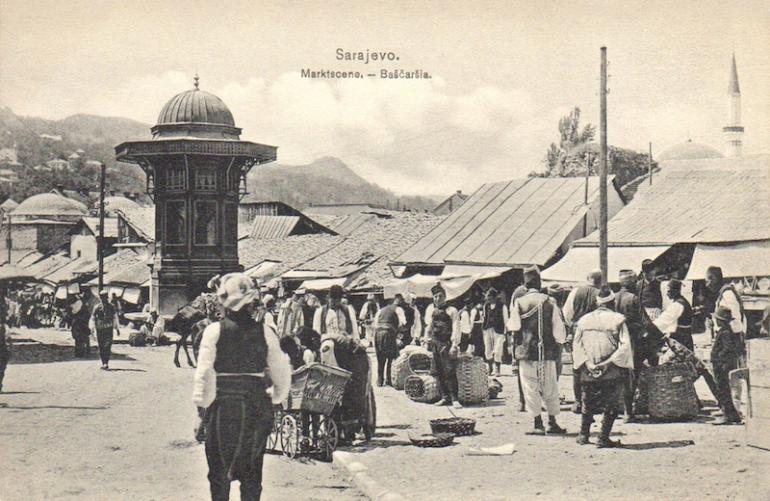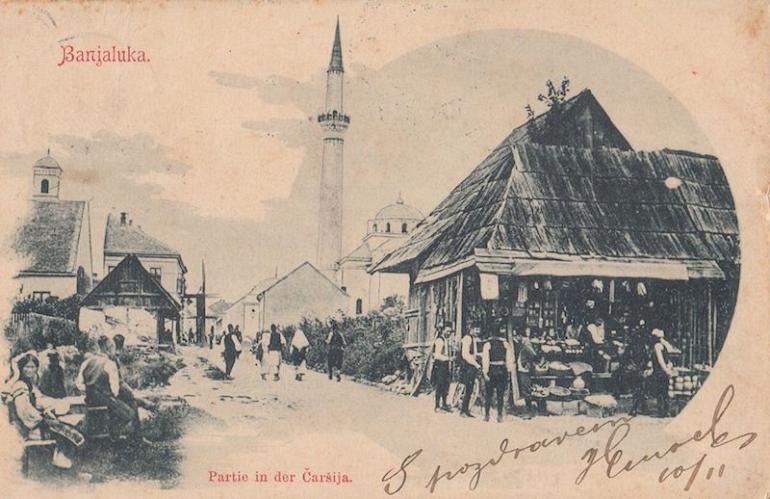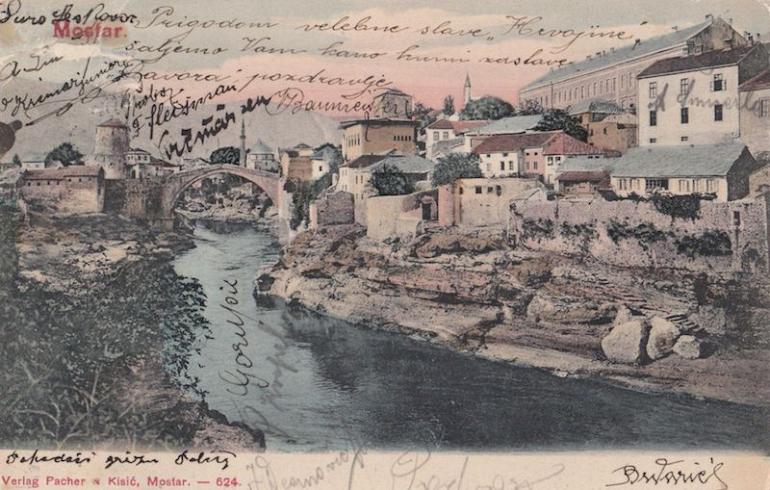This series is presented in partnership with the Heinrich Böll Foundation
A quarter-century since the end of the war, the Courrier des Balkans has started series to examine Bosnia and Herzegovina’s economy and politics, the social and environmental movements making their way through society, and the potential path to a brighter future. These articles will be accompanied by a two-day seminar on 2–3 December.
Recorded by Laurent Geslin | Translated by Clarissa Howe
Xavier Bougarel is a researcher at the French National Center for Scientific Research (CNRS) and part of the Center for Turkish, Ottoman, Balkan, and Central Asian Studies (CETOBAC) at EHESS in Paris. His work focuses on Islam in Bosnia and Herzegovina and Southeastern Europe, the wartime and postwar periods in the former Yugoslavia, and the social history of World War II in Southeastern Europe. He is the author of a number of works, including Anatomie d’un conflit (1996), Les musulmans de l’Europe du sud-est, Des Empires aux Etats balkaniques (co-authored with Nathalie Clayer, 2013), and La division Handschar. Waffen SS de Bosnie (2020).
Specializing in the modern history of Southeastern Europe, Husnija Kamberović teaches at the University of Sarajevo and is the head of the Sarajevo Institute of History. In particular, his research focuses on 19th and 20th-century Bosnia and Herzegovina. The author of over ten works, he contributes to many international journals and is regularly published in Bosnia’s mainstream press.
Courrier des Balkans (CdB) : How do the ethno-nationalist parties that have dominated Bosnia and Herzegovina’s politics since the war ended impose conflicting historical narratives in the areas they control ?
Husnija Kamberović (H.K.) : For awhile now, the political parties have used “their” historians, “their” media, and their agenda to teach history in schools, create their own historical narratives, and promote them as national narratives. These narratives qualify as historical revisionism ; they’re textbook examples of distorting history to political ends. The difference between these narratives, which have been springing up since the 1990s, and the narratives built up by political elites under socialism is that the socialist narratives had an integrative, supranational function whereas these serve exclusively nationalist, divisive purposes. For example, in the Yugoslav era, the narratives around World War II reduced everything to a binary – fascist and anti-fascist, depending on one’s national allegiance. Conversely, the narratives built up in the 1990s not only take a different view of World War II – national antifascism, communist antifascism, with the charge of “fascism” always being leveled at people of other nationalities – but also talk more about the most recent war of 1992–1995, which is the current battleground for those “national narratives”.
The Party of Democratic Action (SDA), the main Bosniak ethno-nationalist party, as well as historians under their influence and sympathetic media outlets, refuse to accept any other interpretation of the events of the last war. When a campaign was launched to erect a monument in central Sarajevo to civilian Serbs who were killed at the beginning of the war in 1992–1993 by members of the Army of Bosnia and Herzegovina, a campaign that some historians supported, the SDA-controlled media opposed it saying that it was an “appropriation of the war narrative”. STAV, the SDA-friendly weekly, even mentioned the need to “save the Bosniak narrative” about the war. The same patterns are at work in the other ethno-political parties. Historians and media outlets close to the Croatian Democratic Union (HDZ) have established a narrative about a war for the homeland against an act of aggression ; they deny any existence of a joint criminal undertaking. At the same time, the Serb political parties, the Alliance of Independent Social Democrats (SNSD) and the Serb Democratic Party (SDS), whose leaders have been found guilty of war crimes and genocide, put all their energy into creating a narrative around an “imaginary genocide” while simultaneously promoting a narrative about how the Serbs suffered.
Xavier Bougarel (X.B.) : These competing historical narratives are already part of school curricula, which are set by the entities and cantons and whose content is saturated with ethnic nationalism despite mitigation attempts by the Council of Europe and OSCE. Beyond the schools issue, there are many hands at work creating these historical narratives. You could point to print and electronic media, which are for the most part under the nationalists’ thumb and are constantly stoking fear and controversy about the war in the 1990s. Then there are also religious institutions, which play a major part in producing separate, conflicting versions of historical memories (including through religious instruction in schools) and veterans’ and victims’ associations that hold memorial ceremonies and put up monuments dedicated only to victims of their own nationality. Even historians mostly focus on the history of their own group and serve dominant nationalist ideologies. Only rarely do you have initiatives such as Sarajevo’s annual History Fest, which provides a regional framework for discussion and debate.
In the 1990s and 2000s, some media outlets, such as Dani in the Federation and Nezavisne novine in Republika Srpska, had a positive role in breaking some of the taboos surrounding the war in the 1990s and Bosnia and Herzegovina’s earlier history, but those discussions have mostly faded away nowadays. The most divisive historical topic within each group rather than between groups remains the World War II Partisan movement. A large part of the Bosnian population still holds on to Yugoslavia’s antifascist legacy despite nationalist historians’ efforts to rehabilitate former Ustaša and Chetnik collaborators. Yet the monuments built during the socialist era have largely been neglected if not destroyed outright. As such, only a few institutions, such as the former Museum of the Revolution (now the Historical Museum of Bosnia and Herzegovina) or the AVNOJ Museum in Jajce are working to keep the memory of Yugoslav antifascism alive. You also have to mention the internet because there is a war raging there between amateur historians who glorify the old 1940s collaborators and those who worship the partisans.
CdB : What “origin stories” are used to create a historical narrative about Bosnia and Herzegovina and the particular identity of the Bosniaks ? When and how did that identity come about ?
H.K. : All countries and peoples create “origin stories”. Under socialism, World War II was seen as the origin of Bosnia and Herzegovina as a state. As a result, Bosnia and Herzegovina’s statist tradition was portrayed as something recent. It is interesting to note, however, that even while the topic was being discussed at the State Anti-Fascist Council for the National Liberation of Bosnia and Herzegovina (ZAVNOBiH), some non-communist members of that Partisan war council insisted on tracing the origins of the Bosnian and Herzegovinian state back to the Middle Ages. Despite that, the prevailing interpretation in socialist historiography was that Bosnia and Herzegovina dated back to World War II. Today, a mostly Bosniak subset of the country purports the Charter of Ban Kulin of 1189 to be Bosnia and Herzegovina’s “birth certificate” while still respecting the decisions made at the ZAVNOBiH in 1943 and 1944. Serbs in Republika Srpska, on the other hand, completely deny Bosnia and Herzegovina’s historical state origins. For them, the founding act of modern Bosnia and Herzegovina is the 1995 Dayton Accords. Neither of these origin stories take any account of the differences between a modern state and a premodern one.
On the other hand, under socialism, not only did the communists recognize the national identities of Muslims, Serbs, and Croats, they promoted them. They rejected a common national identity for all of Bosnia and Herzegovina’s people (Bosnians), saying that it was a nationalist aspiration directed just as much against the country’s Muslims as against its Serbs and Croats. Recently, there has been a resurgence in the idea of “Bosnian-ness” as a national identity for the whole country. A few years after the war, there was even talk of coming up with new national demonyms for Bosnian Serbs and Bosnian Croats, which sparked vigorous debate. Advocates of these ideas drew on the concept of the Western nation-state, scoffing at the historical developments that made this impossible in the Balkans, where national identities came to be determined differently than in Western Europe. At the same time, when it comes to Bosniak ethnic identity, these same advocates insist on tracing the Bosniaks’ distant origins back to the Bogomils. Finally, one of the reference points that the contemporary Bosniak national identity has been built around is the Srebrenica genocide.
X.B. : You can see a rift between two radically opposed types of historical discourse. The first argues that Bosnia and Herzegovina has existed since the Middle Ages or even antiquity. You hear it from both the Bosniak nationalists and anti-nationalist activists. The parts they are divided over generally concern the Ottoman and socialist Yugoslav eras. Bosniak nationalists and especially those groups linked to the Muslim community present the Ottoman era as a period of prosperity and tolerance, whereas the anti-nationalists are much more restrained. It is notable that the Tuzla city council, which is led by non-nationalist parties, talks so much about Tuzla’s “2000 years of continuity” but makes hardly any mention of the Ottoman period. Conversely, the anti-nationalists present socialist Yugoslavia as a period of prosperity and peaceful coexistence while Bosniak nationalists bemoan its anti-religious policies and the supposed domination by the Serbs.
This discourse around Bosnia and Herzegovina’s continuity stands in opposition to the discourse from Serb and Croat nationalists, who present the country’s history as being continually marked by inter-ethnic conflict and its existence as the mere result of an arbitrary decision by Austro-Hungarian or Titoist authorities. Serb and Croat nationalists deem Bosnia and Herzegovina to be “artificial” and made up of immutable national groups. They have always aspired to a state of their own. Today you can see laughable attempts to project the present onto the past. For example, in a bookstore in Banja Luka I found a “History of Republika Srpska” that went back to the Middle Ages ! In the Austro-Hungarian, interwar, and socialist periods, at least some Serb and Croat elites in Bosnia and Herzegovina actually used to defend the country as being politically and culturally distinct. Their words have since faded into oblivion ; today, most people know nothing about that.
The major difference between the three main groups is that the Serb and Croat nationalists can use historical myths that have grown in Serbia and Croatia since the 19th century and fuel powerful scientific institutions such as the Academy of Sciences in Belgrade or the Croatian Institute of History in Zagreb. Bosniak nationalist myths are much more recent and cobbled together because they only existed in rough, fragmented forms until World War II and did not begin to develop until the socialist era through institutions such as the Academy of Sciences of Bosnia and Herzegovina, the Institute for the History of the Labor Movement, and the Oriental Institute.
The 1990s and 2000s were marked by the reemergence and invention of powerful and widespread Bosniak nationalist myths. I can recall two that strike me as particularly important. The first one is about their conversion to Islam under the Ottomans, which is now presented as the voluntary and immediate conversion of local followers of Bogomilism, who were oppressed by the Catholic and Orthodox churches. This “Bogomilist” theory was proposed in the late 19th century by Croatian historian Franjo Rački, but the Bosniak community only really latched onto it after 1990. The second major Bosniak nationalist myth is about a “permanent genocide” that the Muslim community has suffered since the end of Ottoman rule in 1878. This can of course be partially explained by the violence they were subjected to in World War II and the 1990s, but it also tends to portray the Bosniaks as eternal victims that are morally superior to their Serb and Croat tormentors and within their rights to demand protection from the international community.
The historian primarily responsible for the “permanent genocide” theory taking hold is Mustafa Imamović, but the real origin of the discourse is a book published in 1990 by Antun Miletić and Vladimir Dedijer as part of a research project on genocides on Yugoslavian territory funded by, of all places, the Academy of Sciences in Belgrade ! In both of these cases, you can see how Bosniak nationalist myths are created largely by borrowing from Serbian and Croatian historiographical works.
CdB : What historical discourse on Bosniaks was taught in schools in the Yugoslav era ?
H.K. : In socialist Yugoslavia, “Bosnian” was not established as a national identity. Instead, in political, scientific, and cultural spheres alike, constant emphasis was placed on “Bosno-Herzegovinian-ness”. In terms of language, therefore, “Bosnian” did not prevail as the name for the language spoken by all people of Bosnia and Herzegovina. Instead, people spoke of “Bosno-Herzegovinian linguistic expression”. Some people thought of that as a way of defending the Serbs’ upper hand in Bosnia and Herzegovina’s language policy, but I personally believe that calling it by that name was actually an affirmation of what sets Bosnia and Herzegovina apart. The language we refer to today as “Bosnian” has far too much Bosniak influence to be at all acceptable as a name for the language spoken by everyone in the country. Whereas in socialist Yugoslavia the communists in power were extremely cautious in their use of these concepts so as not to pointlessly spread the perception that Bosnia and Herzegovina was a nation-state for one people – which is why they avoided the terms “Bosnian” and “Bosniak” in the national sense – today, even though there is no chance of Bosnia and Herzegovina identifying itself as a one-nation state, these concepts are too often used incorrectly, which opens the door to mistrust and conflict.
X.B. : History classes in socialist Yugoslavia placed particular emphasis on brotherhood and unity among the Yugoslav peoples and on their equal participation in the fight for national liberation from 1941 to 1945. This freed the Muslims of Bosnia and Herzegovina from being identified with five centuries of the “Ottoman yoke” and what nationalist intellectual Alija Isaković referred to in the late 1990s as their “Turkish complex”. The historical rehabilitation of the Muslim nation was incomplete, however, in that history as it was taught under socialism continued to present the Ottoman era as a period of oppression and regression and the contributions of Muslims in Bosnia and Herzegovina to the political and cultural history of Yugoslav peoples continued to be seen as insignificant when compared to, for example, the creation of a Serbian state in 1805 and the invention of Yugoslavism in Croatia in the 19th century.
CdB : Are there any ways in which historians from the Federation and Republika Srpska work together ?
H.K. : Institutional collaboration between historians in Bosnia and Herzegovina is very modest, but interpersonal collaboration works well. It goes to show how much politics has taken control of history. Sarajevo History Fest is one of the latest attempts to build on this collaboration, but we’ve reached an impasse because the historians from Republika Srpska want to present a Serb historiography whereas I think we have to be scientists first and foremost and not representatives of our respective nations. In other words, we need to focus on the professionalization of historiography and not national historiographical perceptions. That would shift the focus to a historian’s professional identity rather than his or her national identity.











